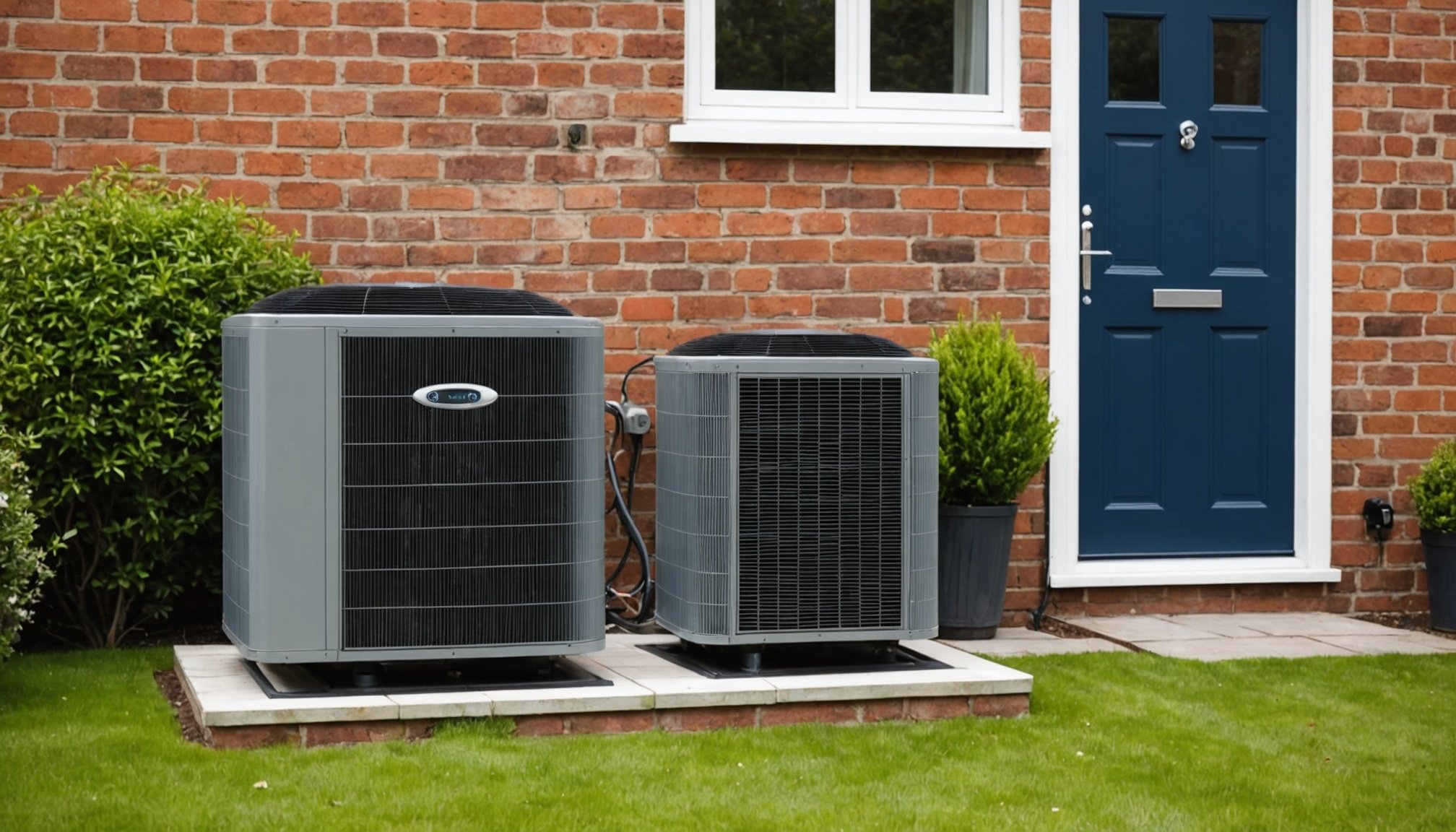Ultimate Guide to Successfully Retrofitting Your UK Home with a Heat Pump: Key Tips and Tricks
Understanding the Benefits of Heat Pumps
If you’re considering retrofitting your UK home with a heat pump, you’re on the right path to reducing your energy bills and contributing to a more sustainable future. Heat pumps are a highly efficient and low-carbon alternative to traditional heating systems, and with the UK Government’s new Warm Homes Plan, there’s never been a better time to make the switch.
The Warm Homes Plan aims to improve energy efficiency, cut heating costs, and promote cleaner energy in homes across England and Wales. This initiative includes grants of up to £7,500 for residents to install heat pumps, making it more accessible than ever to transition away from oil, gas, or LPG boilers[1][3].
Have you seen this : Ultimate tips for successfully installing a solar water heating system in your uk home: best practices unveiled
Choosing the Right Type of Heat Pump
When it comes to selecting a heat pump, you have several options, each with its own set of advantages and considerations.
Air Source Heat Pumps
Air source heat pumps are the most common type and are suitable for most homes. They extract heat from the air and can operate efficiently even in cold temperatures. Here are some key points to consider:
Also read : Ultimate guide to maximizing cavity wall insulation for your uk home
- Cost: Air source heat pumps are generally less expensive to install compared to ground source heat pumps, with costs ranging from £8,400 to £14,050[3].
- Installation: They are easier to install and do not require any groundworks, making them a quicker option.
- Efficiency: They are highly efficient and can provide both heating and hot water.
Ground Source Heat Pumps
Ground source heat pumps involve burying pipes in your garden to absorb heat from the ground. Here’s what you need to know:
- Cost: Ground source heat pumps are more expensive, with installation costs as high as £49,000[3].
- Installation: They require significant groundworks, which can be time-consuming and costly.
- Efficiency: They are very efficient and can provide consistent heat throughout the year.
Hybrid Heat Pumps
Hybrid heat pumps combine the benefits of heat pumps with traditional boiler technology. Here’s how they work:
- Flexibility: Hybrid heat pumps can switch between the heat pump and the boiler based on efficiency and heat demand, offering flexibility and cost savings[5].
- Cost: The cost of installing a hybrid system can vary widely depending on the components and complexity of the setup.
- Efficiency: They offer a balanced approach to heating, leveraging the best of both worlds.
How to Apply for Government Grants
The UK Government offers several grants to help homeowners cover the costs of installing heat pumps. Here’s a step-by-step guide on how to apply:
Boiler Upgrade Scheme (BUS)
- Eligibility: The BUS is available for homeowners in England and Wales who are replacing an existing gas, oil, or LPG boiler with a heat pump.
- Grant Amount: Up to £7,500 for air source and ground source heat pumps[1][3].
- Application Process: You need to find an MCS-certified installer who will apply for the funding on your behalf.
Other Schemes
- Home Energy Scotland Scheme: Offers up to £15,000 for air source and ground source heat pumps, with different eligibility criteria[3].
- Warmer Homes Scotland: Provides grants for air source heat pumps, with a focus on homes with poor insulation or energy efficiency[3].
Removing Barriers to Heat Pump Adoption
The Warm Homes Plan includes several measures to make installing heat pumps easier and more accessible.
Planning Reforms
- One-Metre Rule: The plan will remove the one-metre rule, allowing heat pumps to be installed closer to property boundaries, making the process faster and easier[1].
- Heat Pump Size: The allowed size for heat pumps will be increased from 0.6m3 to 1.5m3, giving homeowners more flexibility[1].
Financial Support
- Vulnerable Groups: The plan prioritizes support for vulnerable households, including renters and low-income families, with targeted financial support[1].
Practical Tips for Retrofitting Your Home
Retrofitting your home with a heat pump requires careful planning and execution. Here are some practical tips to ensure a successful project:
Assess Your Home’s Energy Efficiency
Before installing a heat pump, it’s crucial to ensure your home is well-insulated and airtight. This may involve:
- Loft and Wall Insulation: Ensure your loft and walls are adequately insulated to minimize heat loss.
- Window Upgrades: Consider upgrading your windows to reduce heat loss and improve energy efficiency.
- Draught Proofing: Seal any draughts to maintain a warm and energy-efficient home[2].
Choose the Right Installer
Finding the right installer is key to a successful heat pump installation. Here are some tips:
- MCS Certification: Ensure the installer is MCS-certified to qualify for government grants.
- Experience: Look for installers with experience in retrofitting homes with heat pumps.
- Quotes: Get multiple quotes and compare prices to find the best deal[3].
Consider Underfloor Heating
Underfloor heating can be an excellent complement to a heat pump system, providing an even spread of warmth throughout your home.
- Types of Underfloor Heating: There are various retrofit options available, including plumbed-in wet underfloor heating and low-profile screeded systems[2].
- Installation: Ensure the system is designed to suit your project, taking into account the subfloor and insulation requirements[2].
Financial Considerations and Long-Term Savings
While the initial cost of installing a heat pump can be significant, the long-term savings and benefits are substantial.
Grant Coverage and Additional Costs
Here is a detailed table comparing the grant coverage for different types of heat pumps:
| Grant | Maximum Funding | Eligible Heat Pumps | Coverage |
|---|---|---|---|
| Boiler Upgrade Scheme (BUS) | £7,500 | ASHPs, GSHPs | Covers up to 100% of lower-cost air to air heat pumps; leaves shortfalls for air to water and ground source systems[3] |
| Home Energy Scotland Scheme | £15,000 | ASHPs, GSHPs | Fully covers air to air and air to water systems; leaves shortfalls for ground source systems[3] |
| Warmer Homes Scotland | £10,000 | ASHPs | Covers most air to water systems; leaves shortfalls for ground source systems[3] |
Running Costs and Energy Bills
Heat pumps can significantly reduce your energy bills. Here’s what you can expect:
- Annual Savings: Families can save around £100 annually on heating bills compared to like-for-like gas boiler heating[1].
- Efficiency: Heat pumps are highly efficient, especially when paired with underfloor heating, which operates over a large surface area and requires only warm water[2].
Real-Life Examples and Success Stories
To illustrate the practicality and benefits of retrofitting with heat pumps, let’s look at a real-life example:
Case Study: Retrofitting a Victorian Home
A homeowner in London decided to retrofit their Victorian home with an air source heat pump. Here’s their experience:
- Initial Cost: The installation cost was £12,000, but they received a £7,500 grant through the Boiler Upgrade Scheme.
- Energy Savings: They noticed a significant reduction in their energy bills, saving around £150 per month.
- Comfort: The underfloor heating system they installed provided an even and comfortable warmth throughout the house.
“As we were already planning to renovate our home, installing a heat pump and underfloor heating was the perfect opportunity to make our home more energy-efficient and comfortable. The grant really helped make the project more affordable,” said the homeowner. and Next Steps
Retrofitting your home with a heat pump is a significant step towards a more energy-efficient and low-carbon future. With the right planning, financial support, and practical tips, you can navigate this process successfully.
Key Takeaways
- Energy Efficiency: Ensure your home is well-insulated and airtight before installing a heat pump.
- Government Grants: Utilize government grants to reduce the initial cost of installation.
- Right Installer: Choose an MCS-certified installer to ensure a quality installation.
- Long-Term Savings: Expect significant long-term savings on your energy bills.
By following these guidelines and taking advantage of the available grants and support, you can make your home a warmer, more energy-efficient, and sustainable place to live.
Additional Resources
For more detailed information and to stay updated on the latest developments in heat pump technology and government schemes, here are some resources you can consult:
- UK Government’s Warm Homes Plan: Detailed information on the initiative and how to apply for grants[1].
- GreenMatch Guide to Heat Pump Grants: A comprehensive guide to all available heat pump grants in the UK[3].
- Energy Saving Trust: Advice on ground source heat pumps, including costs, savings, and benefits[4].
By leveraging these resources and following the tips outlined in this guide, you’ll be well on your way to successfully retrofitting your home with a heat pump, contributing to a more sustainable future while enjoying the comfort and efficiency of low-carbon heating.





